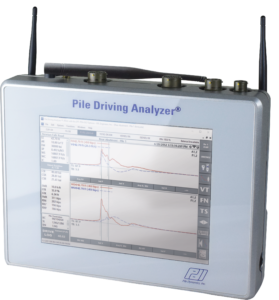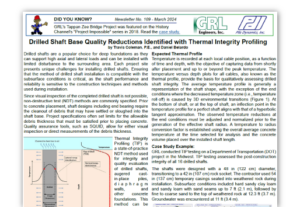I am testing an H-pile that is not listed in the PDA Area Calculator. How do I calculate and enter the cross-section area, the bottom area and the perimeter in the PDA-W program?
Ideally you should look for the parameters in the specification sheet provided by the manufacturer. The steel cross-section area is usually mentioned directly in the specs. To calculate the bottom area and the perimeter of the plugged pile, assume a cross-section corresponding to the square formed by the two lines joining the tips of the flanges and by the two flanges themselves. In the PDA-S or PDA-W program, enter the area simply by typing ARXXX.X and then typing “Enter”, where XXX.X is the cross-section area. To enter the Bottom Area and Perimeter click on the “CW” button, then enter the Circumference (Perimeter) and the Bottom Area in the appropriate boxes.
If you do not have the specification sheet, it is usually possible to determine the values from the type of H-pile (using the “unit weight of steel” and the “nominal weight of the section per unit length”), as explained in the examples below:
SI units – HP 254 x 167 – this means that the flanges and web lengths are equal to 254 mm, and that the mass is 167 kg per meter. We have therefore:
AR = 0.167 x 9.81 kN/77.1 kN/m3 = 0.02124 m2 = 212.4 cm2
Bottom Area = 25.4 x 25.4 = 645.16 cm2
Perimeter = 4 x 0.254 = 1.016 m
English units – HP 12 x 53 – this means that the flanges and web lengths are equal to 12 inches, and the weight is 53 pounds per foot. We have therefore:
AR = 53 lbs/493 lbs/ft3 = 0.1077 ft2 = 15.5 in2
Bottom Area = 12 x 12 = 144 in2
Perimeter = 4 x 12/12 = 4 ft
Return to FAQs



